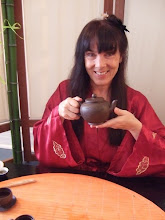

I have had a great interest in the Hina Doll tradition of Japan. The day of March 3 each year the Japanese girls celebrate Hina-matsun, the Doll Festival. When I visited Japan a few years ago it was during Hina-matsun. I was impressed by the beautiful Hina doll displays of the Emperor and Empress. I saw different styles of dolls - some very simply made of paper and more elaborate dolls complete with their stately court, food and flower offerings.
Andreas wanted to gift me with my own Hina Dolls that I later on packed carefully and brought to France. A few days ago I set up my dolls; I arranged flowers, cooked rice and sake around my doll display. But I decided to research what were the roots of the Doll Festival of Japan. What I found lead me into familiar territory.
The tradition began in the Heian period of Japan. It grew out of a tradition called Hina-nagashi that translates into Doll Floating. Small dolls would be fashioned of straw and placed in a little boat. The dolls would absorb the bad spirits that the person might carry. The boat would then be placed in a river to carry the dolls out to sea and free the person of all their bad luck.
The Shrine Shimogamo in Kyoto still celebrates this day, which is called Nagashibina. They float the dolls on the two rivers Takano and Kamo. But rather then leaving the dolls in the water they collect them and burn the dolls back at their temple because so many Hina boats were caught in the fisherman’s nets.
There are also foods that are cooked and served on this special day such as small crackers seasoned with soy sauce, amasake, a rice drink and clam soup. The clam soup is a symbolic food to peacefully unite a couple. Clamshells fit together very closely. But also only the original two shells fit together, which make a perfect match so the drink of this soup was used a blessing for couples.
What I found interesting in this tradition is that both the words Nagashibina and Hina-nagashi contain the word Naga. The origins of this tradition utilized the use of rivers and the sea, the kingdom of the Nagas. Nagashibina was a cleansing ritual of one’s negativity. They used the element of water that is symbolic of cleansing the emotions. The straw dolls acted as an offering to the Nagas. The ancient shamanic traditions often fashioned dolls or offerings formed of barley flour to transfer evil spirits out of the body of a person. My research of the Hina-nagashi tradition confirmed for me the emotional cleansing that can be brought about by making Naga offerings. This is an ancient tradition that has roots in many different cultures around the world.
Andreas wanted to gift me with my own Hina Dolls that I later on packed carefully and brought to France. A few days ago I set up my dolls; I arranged flowers, cooked rice and sake around my doll display. But I decided to research what were the roots of the Doll Festival of Japan. What I found lead me into familiar territory.
The tradition began in the Heian period of Japan. It grew out of a tradition called Hina-nagashi that translates into Doll Floating. Small dolls would be fashioned of straw and placed in a little boat. The dolls would absorb the bad spirits that the person might carry. The boat would then be placed in a river to carry the dolls out to sea and free the person of all their bad luck.
The Shrine Shimogamo in Kyoto still celebrates this day, which is called Nagashibina. They float the dolls on the two rivers Takano and Kamo. But rather then leaving the dolls in the water they collect them and burn the dolls back at their temple because so many Hina boats were caught in the fisherman’s nets.
There are also foods that are cooked and served on this special day such as small crackers seasoned with soy sauce, amasake, a rice drink and clam soup. The clam soup is a symbolic food to peacefully unite a couple. Clamshells fit together very closely. But also only the original two shells fit together, which make a perfect match so the drink of this soup was used a blessing for couples.
What I found interesting in this tradition is that both the words Nagashibina and Hina-nagashi contain the word Naga. The origins of this tradition utilized the use of rivers and the sea, the kingdom of the Nagas. Nagashibina was a cleansing ritual of one’s negativity. They used the element of water that is symbolic of cleansing the emotions. The straw dolls acted as an offering to the Nagas. The ancient shamanic traditions often fashioned dolls or offerings formed of barley flour to transfer evil spirits out of the body of a person. My research of the Hina-nagashi tradition confirmed for me the emotional cleansing that can be brought about by making Naga offerings. This is an ancient tradition that has roots in many different cultures around the world.
(research source Wikipedia)

1 comment:
Such thought and care has gone into this tradition what a beautiful way to release ones negative emotions
Post a Comment